Art World
Do TV Shows Ever Get the Art World Right? Here Are 14 (Even More) Memorable Episodes That Try, Ranked by Believability
In part three of our series, we rank episodes from the most ridiculous to the totally realistic.
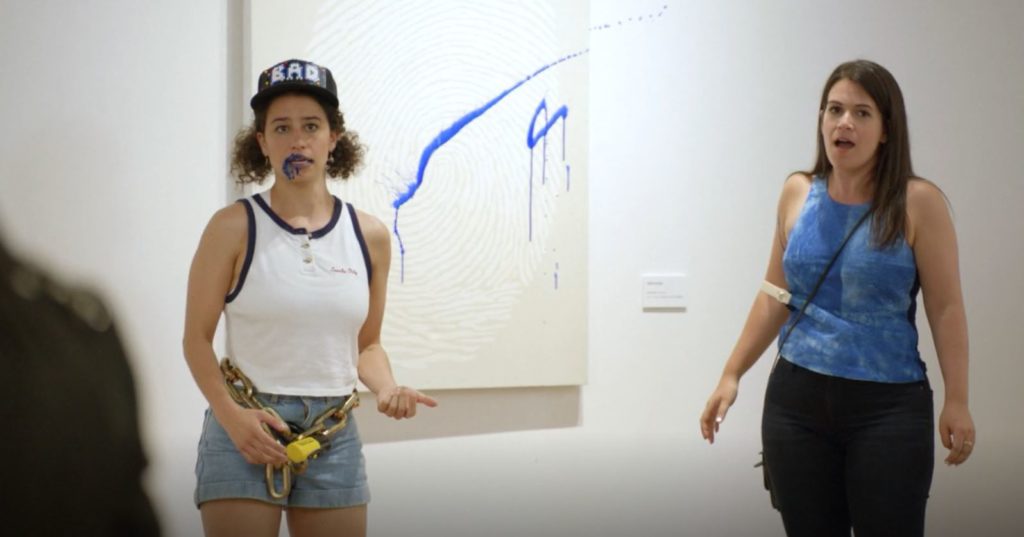
If imitation is the sincerest form of flattery, what about total cock-ups? The art world is an especially cocooned microcosm where money, celebrity, money, auction houses, and money are so intertwined, that real life sometimes seems positively fictional. But alas, sometimes even the best writers can’t match the intrigue of reality.
In part three of our ongoing series (check out parts one and two), we rank 14 shows, from comedies to dramas, by believability.
1. Elementary, “The Adventure of the Ersatz Sobekneferu” (2018)

Watson visits Venetto’s auction house while investigating a murder case. Photo courtesy of CBS.
When Sherlock Holmes and Joan Watson discover a murder victim’s body in the process of being mummified, they realize someone is trying to create a forgery of the female pharaoh Sobekneferu. That mummy, if found, could be worth up to $100 million. Their initial suspect, the so-called Van Faux, is a master forger of Dutch Golden Age paintings. “He doesn’t just copy existing paintings,” Watson explains. “He paints brand new ones in the style of different Dutch old masters, and then passes them off as lost masterpieces.”
By the time Sherlock and Watson track Van Faux down, they discover that the victim was actually his daughter, and that the real murderer is another master forger called the Theban, who once created a fake coffin of Mary Magdalene. There are rumors that the Theban can fool carbon dating tests, but it turns out that his real secret weapon is that he’s an Egyptian antiquities expert by day, regularly hired to authenticate his own fakes. But then the Theban turns up dead as well, and Sherlock and Watson realize that the murder was in fact orchestrated by Armand Venetto of a venerable auction house. Having knowingly sold hundreds of fakes, Venetto realizes his career is in jeopardy.
Sure, there really was a Sobekneferu, and some of the forgery schemes mentioned are true to life (Van Faux is a modern-day Han van Meegeren, who painted faux Old Masters on real 17th-century canvases), but this episode’s outrageous and convoluted plot is straight out of Hollywood.
Believability rank: 2/10
2. Portlandia, “Portland Secedes” (2017)
When graffiti-style art installations start appearing on buildings in Portland, Fred Armisen’s nebbish, stuttering character, Peter, inexplicably becomes convinced that he is in fact the infamous mysterious street artist Banksy.
Peter feels compelled to turn himself in to the authorities and tells a judge in court that he must “answer for his crimes.” The judge is having none of it, and invites Peter outside, where a newly discovered Banksy installation has just gone up on the side of the courthouse. Once again, Peter wonders how he could have done it when he was in court all along (“am I Houdini?” he asks).
When a hooded figure with cans of spray paint pulls off a disguise, revealing that he’s the judge, Peter stammers: “Are you Banksy?” To which the judge replies: “No. Banksy is a construct to help build up the value of low-income neighborhoods.”
As funny as the episode is, Banksy is likely not a judge, and this one fails the reality test.
Believability rank: 2/10
3. Billions, “New Year’s Day” (2019)
What kind of hedge-fund billionaire doesn’t put his art in a freeport?
Apparently, Bobby Axelrod (Damien Lewis), the taciturn head of Axe Capital on the finance soap opera Billions. In a recent episode, Bobby gets an unwanted delivery at his office: Picasso’s Boy With Pipe (1905), with the promise of more than a dozen other works he purchased at Art Basel following closely behind. Just one problem: He doesn’t want them. One of his staff members accidentally routed them to the office, and if he accepts them he will be stuck with an enormous tax bill. What’s a hedge-fund manager to do?
He ends up negotiating a deal with frenemy Danny Margolis (Daniel Cosgrove), who recently bought into a fictitious freeport in Newburgh, New York. The two agree that Axelrod will store replicas of the works at the freeport and live with the real ones at home, all while avoiding a hefty payment to Uncle Sam.
There are just a few things wrong with this yarn. First, there is no way a hedgie like Axelrod—a character reportedly based on mega-collector Steve Cohen—wasn’t already stashing art in freeports. Second, Boy With Pipe sold at auction in 2004 for $104 million. The idea that such a pricey work would be sold at Art Basel, instead of at a megawatt auction, strains credibility.
Believability rank: 2/10
4. Riviera, “Villa Carmella” (2017)
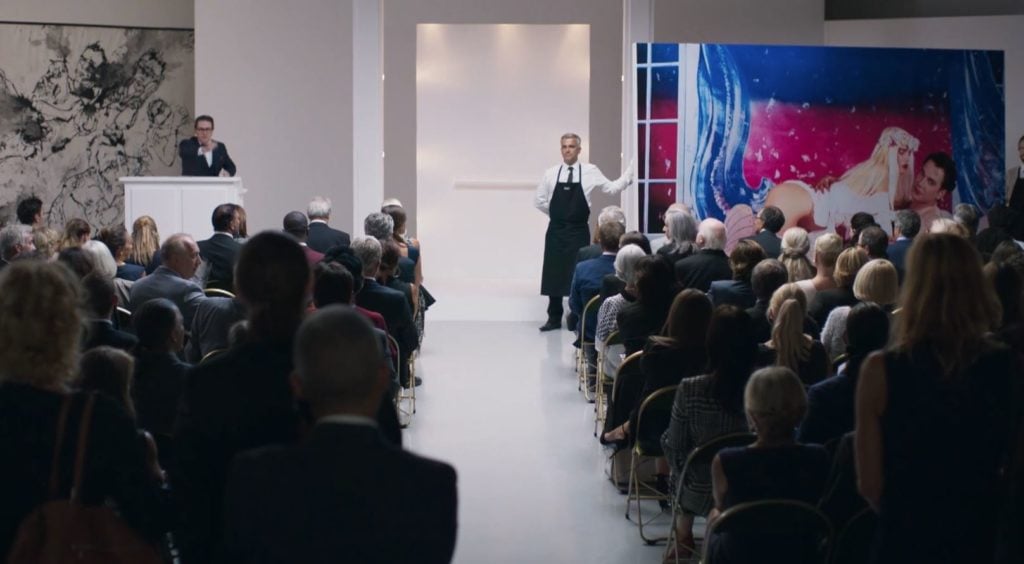
Still from Riviera courtesy of AMC.
“There is nothing as rigorous as money,” shouts Christos Clios (Demetri Leonidas), son of billionaire (and soon-to-be dead) art collector Constantine Clios (Anthony Lapaglia). Christos is strutting across a stage at what looks like a Wall Street investor conference as images of dollars and genuine artworks (including one by British duo Gilbert and George) flash on a screen behind him.
“Where is money most itself? Money is most itself in the last unregulated great bazaar: the art market, where money can do what God intended: accumulate,” he says. “Here, as in Alice’s looking glass, a thing costs what some putative, free-spending, mad hatter says it costs.”
As the camera zooms in and out on Christos, he continues: “We trade Picassos, Rembrandts, Degas, Duchamp! We bundle them the way subprimes are bundled. We sell a Warhol short one day, we hedge an Old Master the next. We get in there before regulation tames the last Wild West.”
On the one hand, it’s easy to imagine a philistine, brazen, money-grubber collector like Christos. But the idea that he would have such literary knowledge (Alice’s looking glass, really?) is pure fantasy.
Believability rank: 2/10
5. Broad City, “Max’s Gallery Show” (2016)
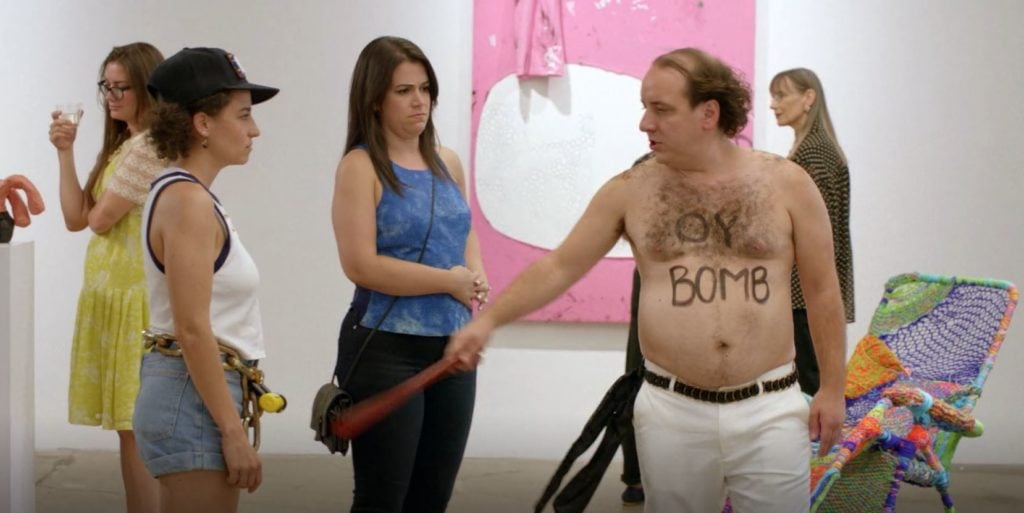
In this episode, Abbi and Ilana go to a gallery opening for Abbi’s former college roommate, who’s an artist. The roommate, Max, is decked out in an over-the-top dress with a dramatic, medieval-looking collar. She’s teetering on huge platform boots. Abbi tells her she looks great, to which Max replies: “I look ridiculous… But you kinda need a look around here.”
They turn their attention to her white-on-white painting. “Be honest, what do you think?” Max asks. “Yeah… it’s… like I get it, I understand it,” Abbi responds. Max then starts describing her process: “I painted it with a feather—not the end that you write with—the soft end of a feather, so it took me two and a half years.” Abbi responds: “Wow! This is like a real gallery dude, they don’t even serve food.”
There is no denying the believability of some of this episode. You can’t event get a stale cracker at a gallery opening anymore. And there is no shortage of strangely dressed art-world people milling about the city. But would a young artist really spend two years on anything? In our Instagram world, where faster is better, it’s hard to imagine anyone having that kind of patience.
Believability rank: 3/10
6. The Girlfriend’s Guide to Divorce, “Rule #36: If You Can’t Stand the Heat, You’re Cooked” (2016)
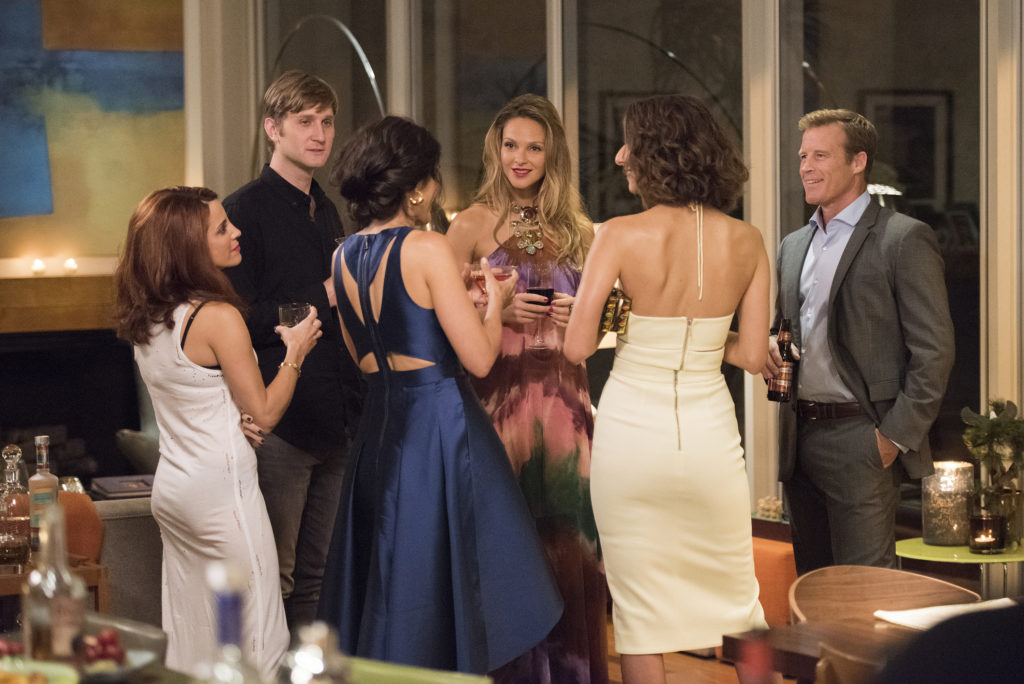
Girlfriends’ Guide to Divorce.
This episode focuses on Phoebe, the tousled-hair, boho-chic, cool mom “with boundary issues.” Having stumbled upon J.D., a young painter with social anxiety, Phoebe decides he is The Next Big Thing, and channels her former career as a model to pose for his Philip Pearlstein-meets-Lisa Yuskavage paintings before tumbling into bed with him and taking the reins of his stalled career (note the boundary issues).
Phoebe calls up her ex-husband Ralf, a moneyed guy in a slick suit, and asks him to come meet her new beau. Ralf praises J.D.’s expert technique (“the genitalia in this piece!”) and Phoebe jumps in squealing, “there is so a show here, right?!”
Oh yes, there sure is, but where to stage it? Phoebe suggests downtown, maybe Skid Row? “Art people love to feel like they’re slumming it,” which, okay, is probably true. Ralf exits with a suggestion: “you find the space, I’ll bring the rich art snobs.” And as promised, by the end of the 38-minute episode, J.D. has sold every work in his impromptu art show and is already struggling with his new identity as a major market star.
Something like this has happened before (see Jean-Michel Basquiat), but it’s not a common occurrence, and this one strains our believability scale.
Believability rank: 4/10
7. Younger, “Sex, Liza and Rock & Roll” (2018)
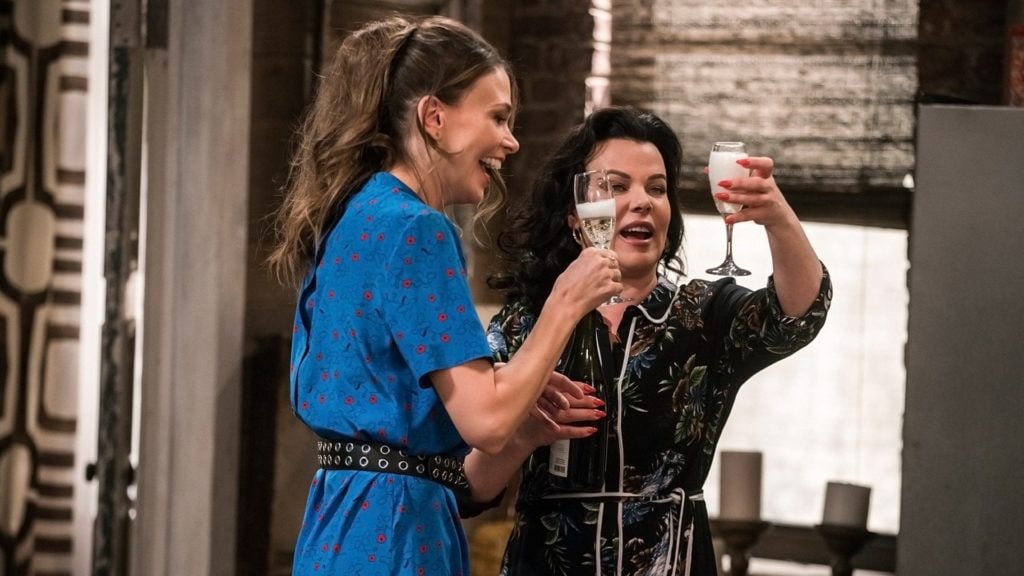
Still from Younger courtesy of TV Land.
Younger tells the story of Liza, a 40-year-old woman who returns to the workforce after years away—and pretends to be 26 to get a job as an assistant at a publishing house.
She lives with her best friend Maggie, an artist who is one of the few aware of Liza’s real age. In this episode, Maggie, who had a loft in Williamsburg before it was cool, finally gets her due: she is invited to be included in the Whitney Biennial. (She helpfully describes it to Liza as “the Super Bowl of the art world,” which, fair?)
The show gets points for genuine emotion from Maggie as a mid-career artist finally being recognized after decades of hard work; for the shout out to ARTnews reporting her inclusion in the show; and for the slick, high-ceilinged gallery space where the exhibition takes place.
But it gets two big demerits: one for the fact that the cocktail party to celebrate the biennial has a black tie dress code (unlikely) and one for the fact that Maggie somehow finds out she is included in the show in the morning, and then by the evening, it all seems to be fully installed and open to VIPs.
Believability rank: 5/10
8. The Marvelous Mrs. Maisel, “Look, She Made a Hat” (2018)
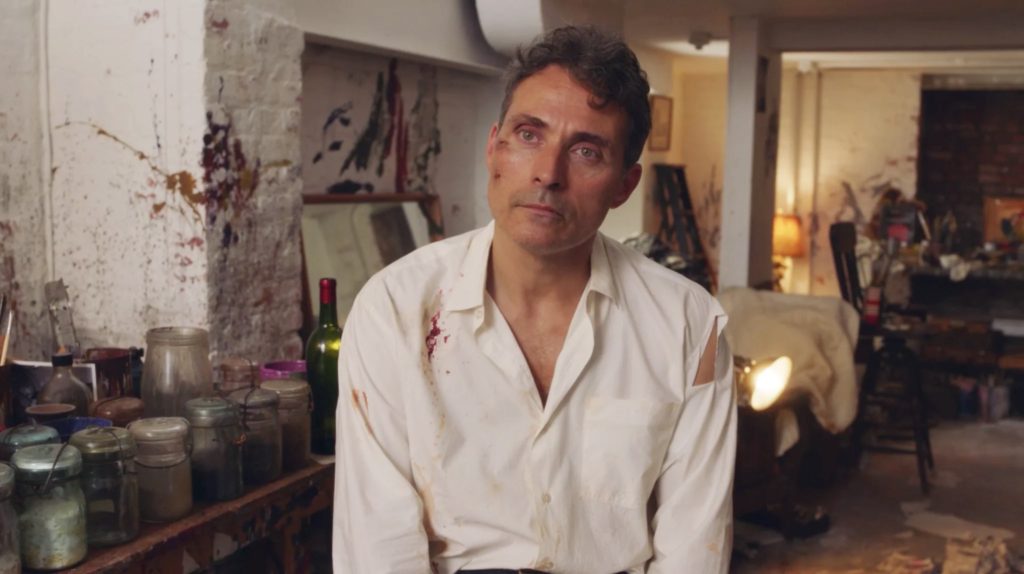
Still of Declan Howell from The Marvelous Mrs. Maisel courtesy of Amazon.
Midge Maisel (Rachel Brosnahan) gets a primer on New York’s downtown art scene from her new boyfriend Benjamin (Zachary Levi), who is awed to spot artists Franz Kline and Robert Motherwell (whose work he collects). But the episode’s real star is Declan Howell (Rufus Sewell), an alcoholic artist who is likely inspired by Jackson Pollock and Willem de Kooning. Howell is “the most famous unknown artist in the world,” Benjamin tells Midge. “He’s considered one of the greats by his peers, but he can’t sell his art.”
Midge finagles a studio visit with Howell, who shows her—but not the camera—his secret masterpiece. “If you want to do something great, you want to take something as far as it’ll go, you can’t have everything,” Howell warns. “You lose family. Sense of home. But then look at what exists.” It’s a reminder, as Midge grows more serious about her career as a comic, of all that she stands to lose—and gain.
The show gets points for sending Midge to real-life artist hangout the Cedar Tavern, but the show’s second season is set in 1959, by which time Pollock was dead, de Kooning was finally making a living off his art, and the Abstract Expressionist movement was winding down.
Believability rank: 5/10
9. Gossip Girl, “The Serena Also Rises” (2008)
In this episode, the mother of Manhattan socialite Serena van der Woodsen has her art collection installed in her Upper East Side penthouse by her art adviser. “Kiki Smith greeting you in the foyer, Elm & Drag pulling you into the main room, and making a statement on the stairwell: Richard Philips,” the consultant intones breathlessly. (The Elmgreen & Dragset work is a version of their Prada Marfa, and the piece de resistance is a scaled-down version of Richard Phillips’s Spectrum from 1998).
This art world cameo is not exactly difficult to believe. All together, the three pieces shown would probably be approaching the million-dollar mark. (The episode aired in 2008, and Phillips achieved his highest price at auction—$384,000—the previous year). But seeing as the combined wealth of the van der Woodsen-Bass empire numbers in the billions, this would be no biggie for Lily.
It’s also pretty believable that she would have an art consultant, as is the case with many wealthy collectors who don’t always have the necessary connections (or good taste) to buy art on their own. This particular consultant would have to be well-connected: according to the artnet Price Database, this Phillips painting has not hit the secondary market yet, so presumably Lily’s consultant got it straight from Gagosian.
The show scores more belieavility points later in the episode, when Phillips himself makes a cameo at an auction to make a snide comment about how “celebutantes” have replaced artists at the center of New York’s art world.
Believability rank: 6/10
10. The Simpsons, “Made About the Toy” (2019)
America’s favorite cartoon family paid homage to Elmgreen & Dragset’s Prada Marfa installation in an episode that aired in January. As the family travels through the small Texas town on a road trip to track down one of Grampa Simpson’s World War II buddies, Homer stops to take a leak on the iconic storefront installation. Meanwhile, Marge mistakes it for a genuine storefront.
As for the believability of this one, sure, it’s easy to mistake Prada Marfa for a real storefront. If you’re speeding through Texas at dusk, as the Simpson family was, you’d be forgiven for driving straight past it. And as for urinating on the building, you’d probably get away with it, as the installation is the only thing on the road for miles (and there are no active security guards on duty, though you might get caught on camera). Just hop the chain-link fence around the back and you’re golden—so long as you don’t mind spectators, as there is often a nonstop stream of people pulling up to get a selfie with the famous installation.
Extra points go to the animators for including the fact that only one of each pair of shoes is included in the installation, which discourages anyone from making any illegal additions to his or her wardrobe.
Believability rank: 6/10
11. Russian Doll, “Superiority Complex” (2019)
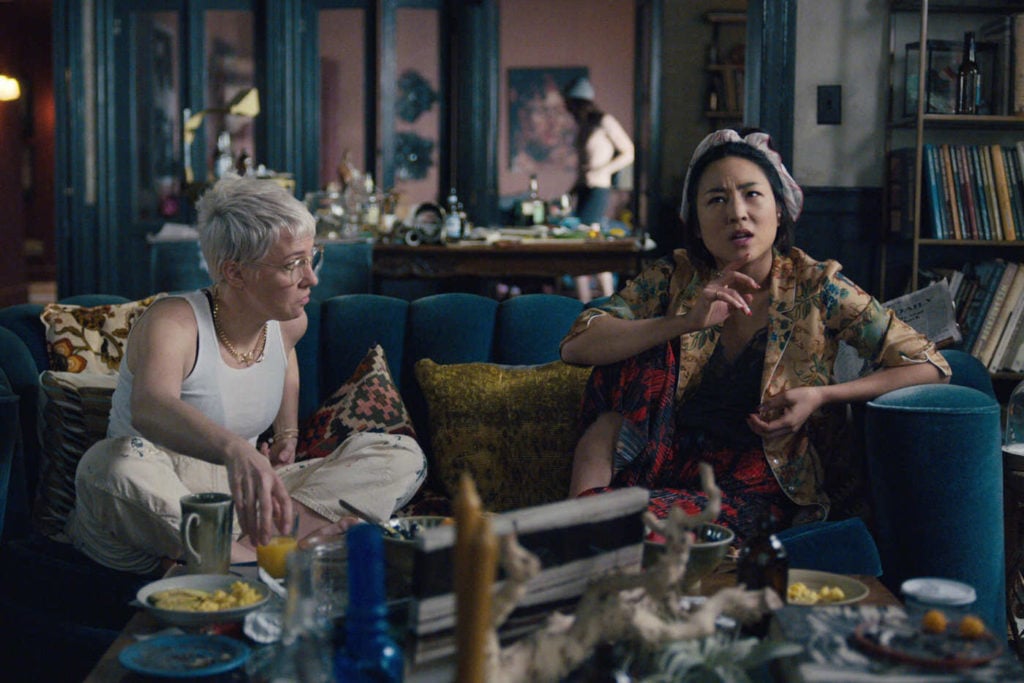
Still from Russian Doll (2019). Courtesy of Netflix.
In this episode of Russian Doll, Nadia (Natasha Lyonne) is at a party in an art-filled home belonging to her friend Maxine.
Contemplating two badly framed drawings with a pretentious academic named Mike (Jeremy Bobb), Maxine expresses her position: “I have a lot of interests and I think there is a lot of merit in copying. I’m interested in plagiarism as an art form.” Mike asks if she ever wonders why art doesn’t have the same power it did decades ago. “I’ve literally never wondered that,” Maxine replies. The non-artsy Alan (Charlie Barnett) interrupts—”the Internet,” he says—to which Mike snaps back “AIDS.”
Neither of them are wrong, but the pure arrogance of the moment and its cringe-worthy awkwardness make for a recognizable scene. (Also, we very much relate to the sentiment of an inescapable art party.)
Believability rank: 6/10
12. The Crown, “Assassins” (2016)
When Parliament commissions the painter Graham Sutherland (Stephen Dillane) to paint an 80th birthday portrait of Winston Churchill (John Lithgow), the prime minister is apprehensive from the start, asking the young artist “will we be engaged in flattery or reality? Are you going to paint me as a cherub or a bulldog?” You see, Churchill is also a painter, and he freely alters what he sees in reality to create a more pleasing picture. “For accuracy, we have the camera. Painting is the higher art,” he intones.
Although the two bond during their portrait session—Churchill comes to realize that his favorite painting subject, a pond at his home, symbolizes his dead daughter—the politician is horrified by the finished product, which he feels like looks like he’s “producing a stool.” Although Sutherland insists that “it’s art, it’s not personal,” Churchill declares him to be “a Judas wielding his murderous brush.”
It’s true that Churchill’s wife burned the painting—although she didn’t do it herself—but The Crown perhaps exaggerates the artwork’s importance to UK political history. On the show, the searing humiliation of the canvas’s unveiling, the unflattering portrayal of the prime minister in old age, provides the final push that convinces Churchill to retire, which isn’t how it really happened.
Believability rank: 7/10
13. The Shield, “Riceburner” (2004)
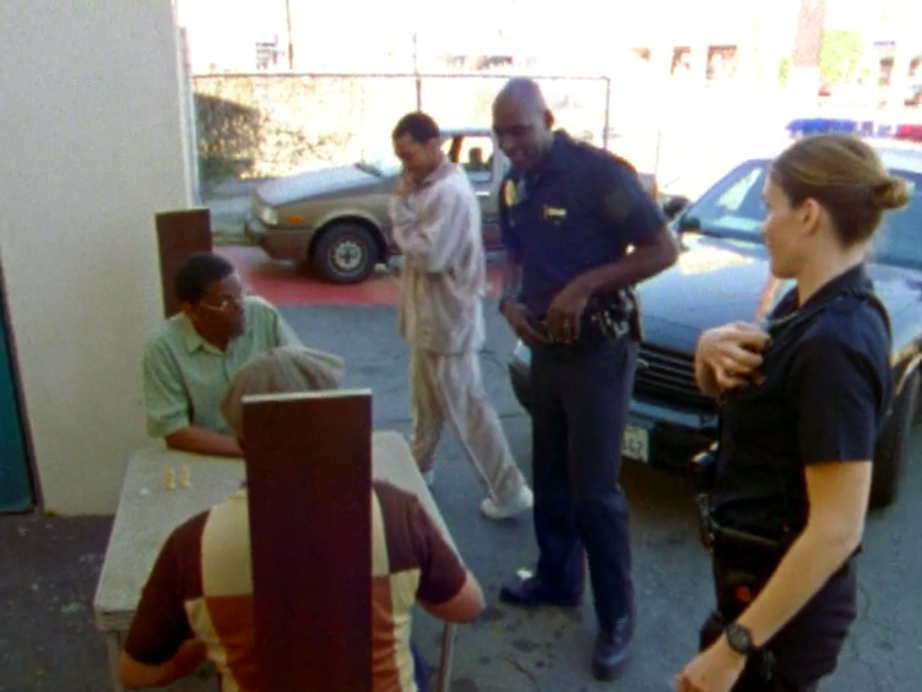
Still from “Riceburner,” an episode from season three of FX drama The Shield.
In a pivotal, disturbing episode of one of the tensest TV series of the 2000s lies a lighthearted and down-to-earth subplot about the market for stolen art, design, and antiques.
With the help of a plugged-in informant (RonReaco Lee), LAPD beat cops Danni Soffer (Catherine Dent) and Julien Lowe (Michael Jace) chase down a pair of high-end chairs—appraised value: $10,000 each—that have been pilfered from the back of a moving truck in downtown Los Angeles. The trail leads first to a pawn shop, where the proprietor says he scoffed at the thieves and their asking price of $200 each, then to a modest furniture store where the owner states that he refused to pay $100 for chairs that look like “torture racks.”
The hunt ends in the parking lot of an unassuming downtown barbershop, where two senior citizens are found playing chess on the chairs. When told their new seating is stolen property, and asked if they’re ready to reveal where they got it from, one of the men replies with an innocent question: “Can we get our 10 bucks back?”
What showrunner Shawn Ryan and his writers get right about art crime is this: It’s not necessarily difficult for hardened criminals to steal valuable works, but good luck flipping them for anywhere near their market value. Unfazed by art-world mythology and pedigree, the average working-class person thinks that contemporary art and design is either a hustle, a delusion, or both.
Believability rank: 8/10
14. The Good Place, “A Fractured Inheritance” (2018)
In this episode, Tahani resolves her lifelong rivalry with her sister Kamilah—but not before trashing the effortlessly successful musician and artist’s exhibition at a Budapest art museum. Tahani joins the queue for Kamilah’s omelet bar/conceptual performance art piece, but resorts to throwing eggs at the paintings when her heartfelt apology is not accepted. Handcuffed by museum security and left to stare at the art while reliving painful childhood memories, Tahani realizes the paintings represent the way the sisters were pitted against one another, and how that rivalry has fueled Kamilah’s creative drive over the years. The two reconcile, and the handcuffs come off.
Easily forgiven art vandalism aside, how realistic is Kamilah’s artwork? Her amazing artist’s statement mentions that her work explores “the relationship between gender politics, copycat violence, and the protective shells we find ourselves in as we grow, mature, and search for meaning. With influences as diverse as Caravaggio, Francis Bacon, and Miles Davis, new variations are distilled from both mundane and transcendent structures.”
On the intellectual fragility and self-flattery of that statement alone, this one wins big on our scale. Who hasn’t read an artist’s statement just like it?
Believability rank: 9/10





